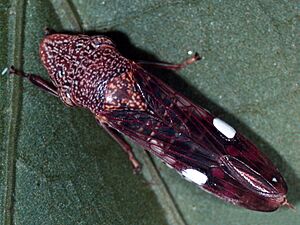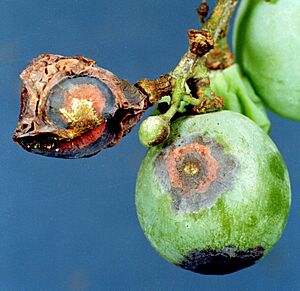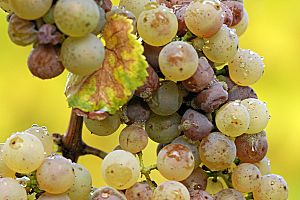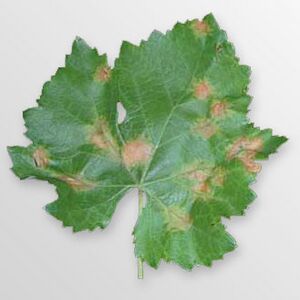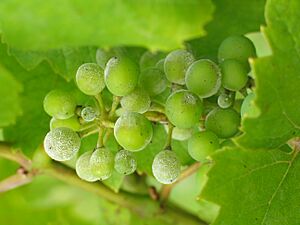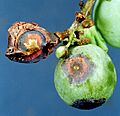List of grape diseases facts for kids
This is a list of common problems that can make grape plants sick. Just like people can get colds or the flu, grapevines can get diseases too! These diseases can be caused by tiny living things like bacteria, fungi, or viruses, or even by problems with the plant's environment, like not getting enough nutrients. When grapes get sick, it can stop them from growing well or producing tasty fruit.
Contents
Tiny Invaders: Bacterial Diseases

Bacteria are super tiny living things, so small you need a microscope to see them! Some bacteria can cause diseases in grapevines.
Pierce's Disease
One of the most serious bacterial diseases for grapes is called Pierce's Disease (often shortened to PD). It's caused by a bacterium called Xylella fastidiosa. This disease is a big problem because it can kill grapevines very quickly.
How does it spread? A small insect called the Glassy-winged sharpshooter carries the bacteria from one plant to another. When the sharpshooter feeds on a grape vine, it leaves the bacteria behind, infecting the plant.
Other Bacterial Problems
- Crown gall: This disease causes lumpy growths, like tumors, on the stems and roots of the grapevines. It's caused by a bacterium called Agrobacterium tumefaciens.
- Happy Disease: This sounds nice, but it's not! It's also known as bacterial necrosis and causes parts of the plant to die.
Fungal Foes: Fungal Diseases
Fungi are living things like mushrooms or mold. Many different types of fungi can attack grapevines, causing a variety of problems.
Common Fungal Diseases
- Anthracnose and bird's-eye rot: This disease causes dark, sunken spots on grapes and leaves, often with a reddish-brown edge. The spots on the grapes can look like a bird's eye.
- Black rot: This is a very common and damaging disease. It causes small, dark spots on leaves and then shrivels the grapes into hard, black "mummies."
- Botrytis (Grey Rot or Noble Rot): This fungus can cause grapes to rot and turn grey and fuzzy. However, in some special cases, especially for certain sweet wines, it's called "Noble Rot" because it helps dry out the grapes, making their sugars more concentrated and creating unique flavors.
- Downy mildew: This fungus causes fuzzy, white patches on the underside of grape leaves. It can make leaves turn yellow and fall off.
- Powdery mildew: This disease looks like a white, powdery coating on grape leaves, stems, and fruit. It can make the grapes taste bad or stop them from growing properly.
- Armillaria root rot: Also known as shoestring root rot, this fungus attacks the roots of the grapevine, causing the plant to weaken and eventually die.
Other Problems: Miscellaneous Diseases and Disorders
Not all grape problems are caused by tiny living things. Some are due to other issues, like not enough nutrients or genetic problems.
- Chlorosis: This happens when grape leaves turn yellow, especially between the veins. It's usually a sign that the plant isn't getting enough iron, which is an important nutrient for plants.
- Little leaf: If a grapevine has small, stunted leaves, it might be suffering from a lack of zinc. Zinc is another important nutrient for healthy plant growth.
- Black measles and Esca: These are complex diseases that cause parts of the grapevine's wood to decay. They are thought to be caused by toxins from certain wood-rotting fungi.
- Fasciation: This is a genetic disorder that causes plant stems to grow in a flattened, ribbon-like shape instead of being round.
- Stem necrosis: This problem causes parts of the grape stems to die, which can lead to grapes shriveling up. It's a physiological disorder, meaning it's a problem with the plant's own processes, not an infection.
Tiny Worms: Parasitic Nematodes
Nematodes are tiny, unsegmented worms that live in the soil. Some of them are parasitic, meaning they feed on plants, including grapevines. They can damage the roots, making it harder for the plant to get water and nutrients.
- Root-knot nematodes: These are very common and cause galls (swollen bumps) on the roots of grapevines. This damage makes it hard for the plant to absorb water and nutrients.
- Dagger nematodes: These nematodes have a long, needle-like mouthpart they use to feed on plant roots. They can also spread certain plant viruses.
Invisible Threats: Phytoplasma, Virus, and Virus-like Diseases
Viruses are even smaller than bacteria and can cause diseases in plants. Phytoplasmas are also tiny, bacteria-like organisms that live inside plants. These diseases can't be cured with sprays like some fungal diseases.
- Grapevine leafroll: This is one of the most widespread virus diseases in grapes. It causes the leaves to roll downwards and turn red or yellow in the fall, even before normal autumn colors appear. It can reduce the quality and amount of grapes produced.
- Fanleaf degeneration: This virus causes grape leaves to look distorted, like a fan, and can lead to poor growth and fruit production.
- Grapevine red blotch: This disease causes red or purple blotches on the leaves, especially in red grape varieties. It can affect how well the grapes ripen.
- Grapevine yellows: This is caused by phytoplasmas and makes leaves turn yellow, and shoots may not grow properly.
Images for kids
See also
- Ampeloglypter ater
- Ampeloglypter sesostris
- Ampelomyia viticola
- Eupoecilia ambiguella
- Great French Wine Blight
- Japanese beetle
- Maconellicoccus hirsutus
- Otiorhynchus cribricollis
- Paralobesia viteana
- Pseudococcus maritimus
- Pseudococcus viburni
- Zenophassus


